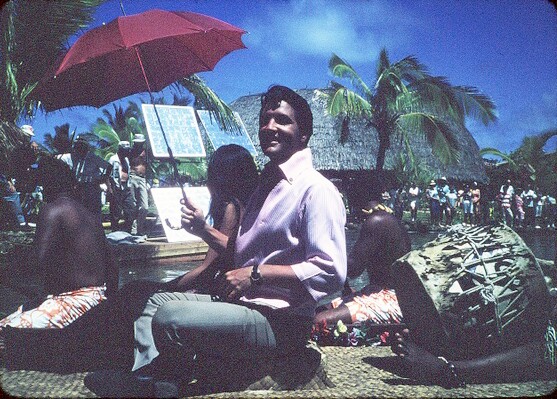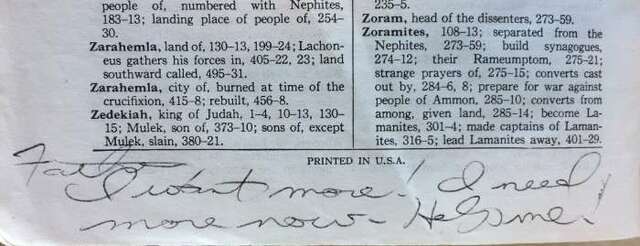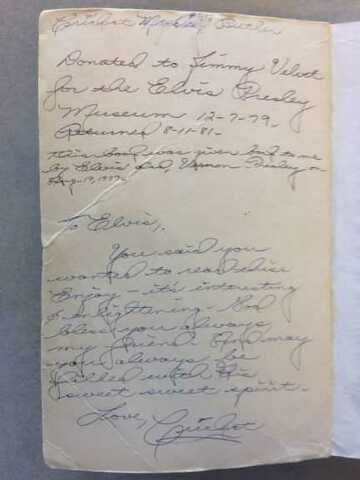This story appeared in the March/April 2020 issue of LDS Living.
Over the last three decades, word of the Church’s acquisition of a Book of Mormon supposedly written in by Elvis Presley spread easily through fireside speakers, classroom teachers, and newspaper columnists. Requests to see and touch the book came repeatedly, so much so that by 2002 the book’s binding had cracked and a digital copy was made for visitors who came each week for a peek. Now, more than 40 years after Presley’s death, the story of his handwriting in this Book of Mormon continues to circulate regularly throughout Latter-day Saint culture.
Perhaps the most surprising part of this story is how confidently the tale has been told with so little analysis. This, it seemed, was a storyteller’s dream—a faith-promoting story with touchable roots in the Church’s historical collection.
I had heard the story of this book numerous times in the nearly six years that I served as director of the Church History Library, but I only called the book out of the stacks after a Salt Lake City television station wanted to film yet another telling. As I examined the volume in the fall of 2018, the annotations on its pages immediately raised more questions than answers. Internal records revealed that others had likewise questioned the book’s authenticity, as early as 1991 and as recently as 2008. My research accelerated, drawing on a host of recently published works that document Elvis’s life and activities more clearly than ever before.1 By examining the opportunities for Presley to have read this volume and by carefully analyzing the handwriting throughout its pages, I can now affirm that Elvis Presley did not write in this Book of Mormon.2
About the Collection
Though the copy of the Book of Mormon purportedly marked by Elvis has received most of the attention in the media and popular culture, the Church History Library actually holds a collection of six items related to this story: two books and four photographs. In 1989, the donation of the Book of Mormon was accompanied by three photographs. In 2002, Cricket Coulter, who donated the Book of Mormon, also contributed a two-in-one volume containing the Doctrine and Covenants and Pearl of Great Price and another photograph.3
The donated Book of Mormon was published in 1976 with a soft, light-blue cover featuring a golden angel Moroni.
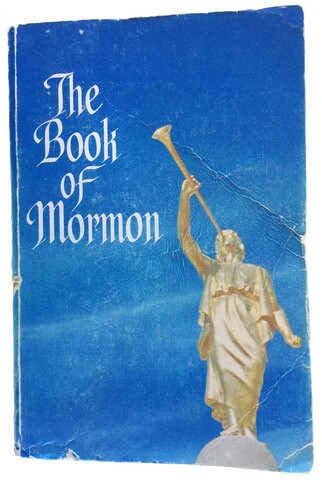
The Book of Mormon in the Church History Library collections claimed to have been read by Elvis.
Within the Book of Mormon volume are handwritten annotations on 89 of the book’s 558 pages—nearly 1 of every 6 pages. The first annotation appears on the first page of the book and the last one on its last page (page 558, in the index), giving the impression that Elvis read the entire book and engaged with its contents from beginning to end. There are a total of 103 words written in the margins through the entire book. The quantity and length of the annotations, together with the appearance of only one style of handwriting, provide opportunity to analyze this handwriting and compare it to authentic samples of Elvis’s known writing. But first we must consider the question of whether the book could have even found its way into his hands.
Provenance
The basic outline of how this copy of the Book of Mormon made its way into the Church’s archives has been repeatedly told in the news media. It all started with superfan Cricket Coulter, who had followed Elvis Presley for more than a decade before giving him the book. Coulter lived in an apartment near Presley’s home in California. Additionally, she had two other homes—one near Presley’s Graceland home in Memphis and another near his home in Las Vegas. She attended 533 of his concerts, and appeared as an uncredited fan in his 1970 documentary Elvis: That’s the Way It Is. She was baptized into the Church in Memphis in the summer of 1976.4
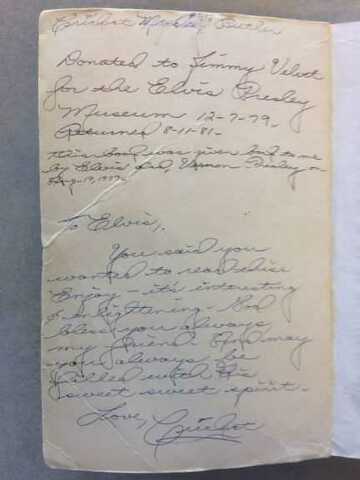
A note from Cricket Coulter to Elvis written in the front cover of the Book of Mormon.
Coulter reports giving the book to Elvis on August 2, 1977, and that his father returned it to her on August 19, 1977. Over the years, she shared two different stories about why the book was returned to her. In one version, Vernon Presley didn’t want Elvis’s interest in the Church to be known, so he slipped the book out of the house and into her custody. In the other story, because Cricket was a fan of the Osmonds as well as Presley, she reported that the book was given to her to pass along because Elvis wanted the Osmonds to have it.5 In either case, Coulter later showed the book to Alan Osmond, who "interviewed her on cassette tape" and "had her sign a letter of authenticity." Having documented Coulter’s claims, Osmond forwarded the book to Elder Rex Pinegar, a relative by marriage then serving as a general authority, who delivered the book to the executive director of the Church Historical Department.6 The volume was accessioned into the Church’s collection in July 1989. Thanks to Alan Osmond’s careful documentation, the chain of provenance from Coulter to the Church is thoroughly recorded, but what about the most important links in the chain, those between Coulter and Elvis Presley? Did Elvis read and mark this copy of the Book of Mormon during the 14 days that it was reportedly in his possession in August 1977?
The last two weeks of Elvis Presley’s life were anything but uneventful.7 He returned to Graceland from touring at the end of June 1977, and his 9-year-old daughter, Lisa Marie, arrived on July 31. Beyond his daughter, he saw few people during these weeks, principally a few close friends, his doctor, and his 20-year-old fiancée, Ginger Alden, who brought her 10-year-old niece along to play with Lisa. During this period, Elvis rode motorcycles once, played racquetball once, rented the local amusement park to entertain the kids, and held a private screening of several films. On one evening, he and Ginger visited her family, where he sang and talked excitedly about numerology. Beyond hosting his daughter and visiting family, Elvis was also reeling from the publication of a devastating exposé of his prescription drug abuse and violent behavior. The book, titled Elvis, What Happened? relates numerous experiences from three of his former bodyguards about his careless and reckless behavior.8 His biographer notes that Elvis "alternated between bouts of depression and moments of defiance" as well as "waves of shame and rage" as he worried about the book and his career.9 And he was preparing to leave on tour on August 16, which involved "many hours and days of planning and coordination.” Alden reported that Elvis read "some spiritual books" during the summer but named only A Scientific Search for the Face of Jesus about the Shroud of Turin and Sex and Psychic Energy.10
In the midst of hosting his daughter, worrying about the exposé, and planning for his upcoming tour, did Elvis receive a copy of the Book of Mormon, Doctrine and Covenants, and Pearl of Great Price from Cricket Coulter? It is possible. Did he read and ponder the nearly 1,000 pages of text in the volumes and leave handwritten annotations on 112 of those pages? It is very unlikely.
Handwriting Analysis
The content of the annotations has so captured public imagination that the fact that the book contains a signature has scarcely been mentioned. But neither the signature nor the marginal annotations match authentic samples of Presley’s handwriting, a fact corroborated by leading external authenticators of Elvis Presley’s handwriting.
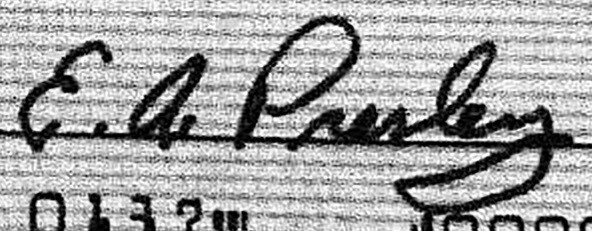
Authentic signature courtesy of Keith A. Erekson, with permission from Roger Epperson
Signature
The first page of the Book of Mormon contains the forged signature "E. A . Presley."

Music industry autograph authenticator and collector Roger Epperson provided the most thorough history of Presley’s handwriting in a two-part series for Autograph Collector magazine, subtitled "The Story of Elvis’ Autograph through Every Loop and Turn." He observed that Elvis was "consistently inconsistent . . . in the way he signed." Further, by the 1970s, the combination of stress and poor health was reflected in handwriting that grew more “shaky and inconsistent” and lost its previous "easy fluidity."11 Nevertheless, to the careful observer, there are "some consistencies"12 in Elvis’s autograph that can be used to establish that Elvis Presley did not sign the Book of Mormon in the Church History Library.
Several elements of the forged signature resemble known general characteristics of authentic signatures. For example, if Elvis did sign "E. A. Presley," the line of the signature rises to the right, and he typically wrote the words on a single line.13 The forger knew a little bit about Presley’s signature. Despite a general resemblance, however, significant differences appear in nearly every letter. The two biggest are the connection between the "P" and "resley" and the missing second "e" in the forged signature, two telltale signs of forgery.14 Collectively, the differences add up to a clear determination of a forged signature. Elvis Presley did not sign this copy of the Book of Mormon.
Marginal Annotations
If the forged signature displays a general hint of Elvis, the marginal annotations throughout the Book of Mormon in the Church History Library demonstrate almost no resemblance to authentic samples of Elvis’s handwriting. Authenticator Bill White characterizes Elvis’s surviving handwriting as "somewhat erratic," "jerky," and "childish-looking."15 The most famous sample is a six-page letter penned to President Richard M. Nixon on December 21, 1970, that Elvis signed on multiple pages.16
Elvis Presley was a reader and a book annotator, and several samples survive of his handwriting in the margins of books. His daughter has observed that the books in his personal collection are "covered with his notes. He wrote on the top of the page, on the bottom of the page, in the margins—everywhere."17 All of the authentic samples reveal the same pattern—Elvis customarily underlined with heavy, crooked lines and wrote in block print letters.
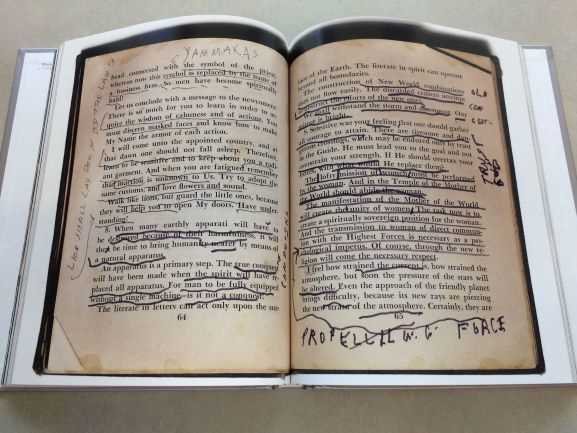
Authentic handwriting, courtesy of Keith A. Erekson
Among the surviving books with authentic annotations are also a few Bibles. One Bible that Elvis marked in 1959 contains an inscription to his recently deceased mother and annotations in several places throughout.18 Whereas Elvis’s authentic handwriting is rough script or squared print, the forged script annotations are so smooth, so "mature," and so legible that they are clearly a forgery.19
Beyond the mechanics of handwriting, the content and style of the forged annotations in the Book of Mormon differ from authentic annotations. In Elvis’s authentic Bible annotations, his words frequently repeat words in the text. For example, he underlined the words "Be still, and know that I am God" in Psalm 46:10 and wrote in the margin, "BE STILL AND KNOW THAT I AM GOD." Next to Psalm 118:8, which reads, "It is better to trust in the Lord than to put confidence in man," he wrote, "TRUST IN THE LORD NOT MAN."20
In contrast to Elvis’s known practice of emphasizing the printed text, the forged annotations in the Book of Mormon present a dialogue-like engagement with and extension of the text in a way that appears forced at best and tongue-in-cheek at worst. For example, the forger underlined passages about excessive drunkenness (2 Nephi 15:11) and King Noah’s whoredoms (Mosiah 11:2). Beneath a photograph of an ancient gold tablet, the smooth-handed forger wrote, "gold records—real ones." Underlining "Thou shalt have no other God before me" (Mosiah 12:35), the forger wrote, "Fans = Not me either."
But the forger also wanted readers to see a change in Elvis’s heart. Underlining Alma’s warning to his sexually promiscuous son Corianton about unpardonable sins (Alma 39:6), the forger dialed up two cursive I’s to write the book’s longest annotation: "I could never deny that which I know in my heart to be true." Next to the underlined words "They were desirous to be baptized" (Mosiah 21:35), the forger wrote, "me too." But these forged desires would not come to pass, as the forger suggested that Elvis seemed to know all too well. Next to the underlined words "And now I go unto the father" (3 Nephi 18:35), the forger again wrote, “me too.” If this imagined Elvis had a premonition of his own imminent death, he also found hope for the future in the most widely quoted forged annotation—beneath an underlined warning from Mormon that "awful is the wickedness to suppose that God saveth one child because of baptism" (Moroni 8:15), the forger wrote, "My Lisa needs this church. She’s only 9. Help her for me." The annotations in this volume are fabrications manufactured to deceive.
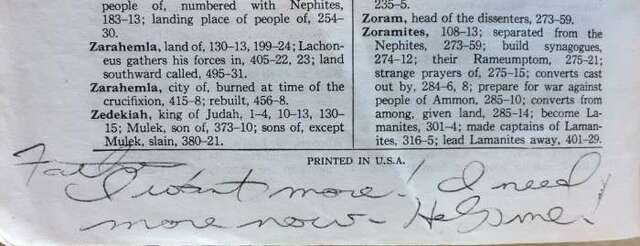
Forged annotations. Courtesy of Keith A. Erekson
Forgeries are often accepted because they provide something that people already want; in this case, the story of a changed heart, the conversion of a celebrity, and a testimony of the Church. Many people hoped for a religious Elvis, and for Latter-day Saints the forged annotations in this volume answered that longing.
External Authentication
After drawing my own conclusion that the handwriting in the Book of Mormon was not made by Elvis Presley and receiving encouragement from handwriting experts in the Church History Department, I submitted writing samples independently to five Elvis Presley authenticators. I shared the signature from the book’s first page and 17 annotations.
All five authenticators are unanimous in declaring the signature and annotations to be the work of someone other than Elvis Presley.
Rich Consola is a collector, authenticator, and owner of Elvis Presley Authentication, who specializes in the autograph and handwriting of Elvis Presley. Consola wrote: "After reviewing the signature of Elvis Presley and all the writing in this book, it is my opinion that NONE of the writing and the signature are that of Elvis Presley. To this end I am very certain."21
"All Shook Up"
The results of this historical and handwriting analysis can be stated quite clearly: Elvis Presley did not write in the Book of Mormon held by the Church History Library. The story of the book’s provenance—its being given to Elvis 14 days before his death and being read and digested from first page to last—does not fit within the constraints of a period in which he hosted his daughter, prepared for a tour, and responded to an exposé about his prescription drug abuse and erratic behavior. Further, analysis of the handwriting in the Book of Mormon volume—a signature and three dozen smoothly written annotations—reveals dramatic departures from Presley’s authentic handwriting as well as differences in the style of his marginal annotation. After nearly three decades of uncertainty, this investigation can turn on the popular culture public announcement system to declare without hesitation: "Ladies and gentlemen, Elvis has left the library."
Where does this verdict of forgery leave Elvis Presley’s relationship to the Church and its members? Elvis was a seeker who read the Bible, sang gospel music, wondered about the purpose of life, missed his deceased mother, and explored many philosophies and religions, striking up conversations with his maid, his hairdresser, and anyone else who would talk.22 Elvis’s best-documented Latter-day Saint friend was his karate instructor and later bodyguard, Edmund Kealoha "Ed" Parker. Presley’s biographer observes that Ed, a BYU sociology graduate, developed a form of Kenpo (multiple martial arts) that fascinated Elvis, and the pair "spent time out by the pool, talking about karate and the Islands, about Parker’s royal Polynesian heritage and his Mormon beliefs."23 In a memoir written shortly after Elvis’s death, Parker reported giving Elvis a copy of the Book of Mormon, which they discussed, and he related tales of talking with Presley about life, death, resurrection, psychic healing, UFOs (both claimed to have seen one), indigenous ancestors (Parker’s in Hawaii and Elvis’s among the Cherokee), proxy temple work, numerology, end times, and island Kahunaism.24

From the BYU-Hawaii archives, courtesy of Keith A. Erekson
Elvis also made connections with the Church and its members through his work. His 1966 film, Paradise, Hawaiian Style, was filmed at the Polynesian Cultural Center in August 1965.25 Presley was also acquainted with the Osmond family, sharing the same drummer and jumpsuit designer in Las Vegas. Mother Olive Osmond gave Elvis a Book of Mormon, and he gave the Osmonds flowers in the shape of a guitar. Elvis and Olive talked by phone about his mother and the purpose of life, and his sudden death preempted a barbeque he had scheduled with the family.26 When I shared the findings of forgery with Alan Osmond, he was both surprised and saddened. Over the past 30 years, he had told the story in fireside talks, on his website and blog, and in media interviews. Though clearly a victim of the forger, Alan quickly recognized the strength of the evidence and said, "The Church is true, and it doesn’t need Elvis’s name. I am thankful that you have checked this out. We want to put closure on this."27 To me, Alan provides an inspiring example that it is okay to change one’s view when new evidence is uncovered.
What about other stories regarding Elvis and the Church that circulate amongst the Saints? One lesson to learn from this forgery is not to draw conclusions that reach beyond the evidence. If you rely on the stories about celebrities like Presley to strengthen your conversion, then you face the possibility of later getting "All Shook Up."
This article has been condensed from a BYU Studies article, “Elvis Has Left the Library: Identifying Forged Annotations in a Book of Mormon.”
End Notes
1. I acknowledge Brandon Metcalf, Christy Best, and Robin Jensen for reviewing my preliminary findings and coaching me in the art and science of handwriting analysis. Brian Reeves, Jeff Anderson, Steve Sorenson, Glenn Rowe, and LaVonne Gaw walked this pathway before me, leaving clues to guide my way. Joan Nay, LisAllen, Keali‘i Haverly, and Brooks Haderlie aided my research.
2. These findings were announced in Keith A. Erekson, “Elvis Presley’s Copy of the Book of Mormon Ain’t Nothin’ but a Forgery, Church History Experts Say,” Church News, November 14, 2018.
3. Cricket Marie Coulter, “Annotated Copies of the Book of Mormon and Doctrine and Covenants, 1976–1977,” Church History Library.
4. Denis Sanders, Elvis: That’s the Way It Is, documentary, 1970.
5. The first version is reported in Peggy Fletcher Stack, “Elder Elvis? Was the King Close to Converting to Mormon Faith?”Salt Lake Tribune, July 14, 2001; the second appears in Donny Osmond and Patricia Romanowski, Life Is Just What You Make It (New York: Hyperion, 1999), 168–69.
6. Stack, “Elder Elvis?” C1; Arave, “Elvis Almost LDS?”; Hardy, “Film Explores Elvis-LDS Link.”
7. The timeline is reconstructed from Peter Guralnick, Careless Love: The Unmaking of Elvis Presley (Boston: Little, Brown, 1999),641–61; Peter Guralnick and Ernst Jorgensen, Elvis: Day by Day (New York: Ballantine Books, 1999), 376–79; Ginger Alden, Elvis &Ginger (New York: Berkley Books, 2014), 327–29, 331–32.
8. Red West, Sonny West, and Dave Hebler, as told to Steve Dunleavy, Elvis, What Happened? (New York: Ballantine Books, 1977).
9. Guralnick, Careless Love, 643–44.
10. Nancy B. Rooks and Jim Cox, Inside Graceland: Elvis’ Maid Remembers (Bloomington, Ind.: Xlibris, 2005), 96–98; Alden, Elvis & Ginger, 324, 338–39. Frank O. Adams, A Scientific Search for the Face of Jesus (Tucson, Ariz.: Psychical Aid Foundation, 1972); Betty Bethards, Sex and Psychic Energy (Novato, Calif.: Inner Light Foundation, 1977).
11. Roger Epperson,“It’s Good to Be King: The Story of Elvis’Autograph through Every Loop and Turn, Part I: 1955–66,” Autograph Collector (April/May 2007): 55; Roger Epperson, “Elvis: The Later Years, 1967–1977,” Autograph Collector (August/September 2007): 83.
12. White, “Collector’s Guide to Elvis.”
13. White, “Collector’s Guide to Elvis”; Gomersall, “Authenticating Elvis Presley Autographs.”
14. White, “Collector’s Guide to Elvis”; Roger Epperson, email to Keith A. Erekson, October 17, 2018.
15. White, “Collector’s Guide to Elvis.”
16. Document R-013 re Elvis-Nixon meeting, White House Central Files: Subject Files: EX HE 5-1, Nixon Presidential Materials Staff, National Archives and Records Administration.
17. Lisa Marie Presley, quoted in Ritz, Elvis by the Presleys, 111.
18. A photograph of Elvis’s inscription about his mother is reproduced in Martin Beckford, “Elvis Presley Wrote ‘I Love Ya Mama’ on Bible after Mother’s Death,” (London) Telegraph, May 12, 2010.
19. White, “Collector’s Guide to Elvis.”
20. See a photograph of the annotation of Psalm 11 in Harper, “Sing for the Glory of God”; summaries of the other passages appear in Goins-Phillips, “Elvis Presley’s Handwritten Notes.”
21. Moseley, “Collecting Elvis,” 49; Rich Consola, email to Keith A. Erekson, October 10, 2018, emphasis in original.
22. See Guralnick, Careless Love, 173–225; Rooks and Cox, Inside Graceland, 25; Larry Geller and Joel Spector with Patricia Romanowski, “If I Can Dream”: Elvis’ Own Story (New York: Simon and Schuster, 1989).
23. Guralnick, Careless Love, 73. Guralnick and Jorgensen, Elvis: Day by Day, 154.
24. Parker, Inside Elvis, 131, 138, see especially 131–52.
25. See “Presley Thrills Fans in Laie as He Appears for Movie,” Ke Alaka‘i (BYU–Hawaii), September 24, 1965, 2; Mike Foley, “MPHS, LCA and BYUH History Department Sponsor ‘Movie Night,’” BYU–Hawaii Newsroom, November 27, 2006.
26. Alan Osmond, phone call with Keith A. Erekson, October 17, 2018; Osmond with Romanowski, Life Is Just What You Make It,168–69.
27. Alan Osmond, phone call with Keith A. Erekson, October 17, 2018.



